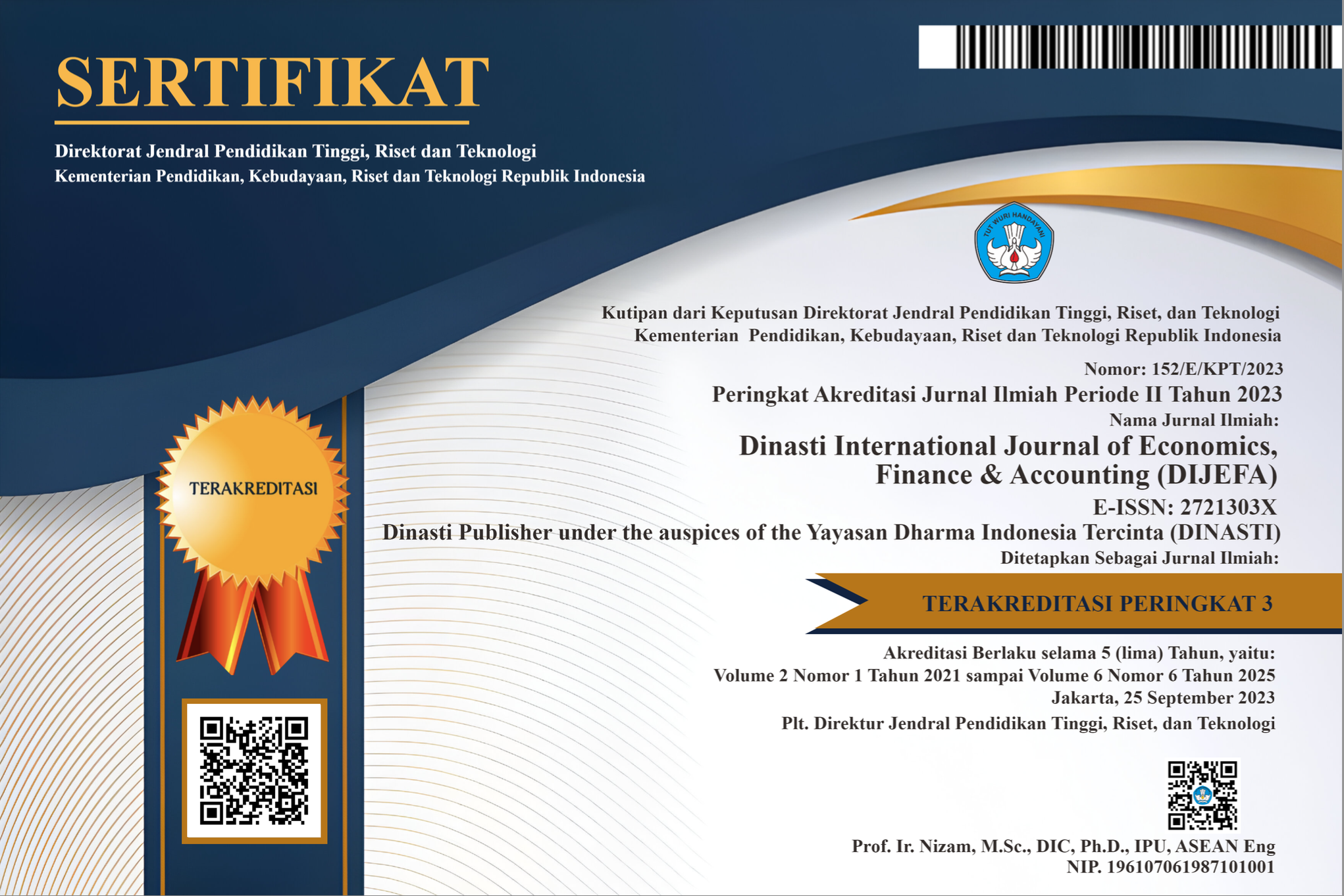Analyzing Firm Performance: The Influence of Enterprise Risk Management, Investment Decisions, and ESG Aspects in ASEAN-5 Non Financial Firms
DOI:
https://doi.org/10.38035/dijefa.v5i3.2744Keywords:
Enterprise Risk Management (ERM), Investment Decisions, Environmental, Social And Governance (ESG), Firm Performance, ASEAN-5Abstract
This study aims to examine the effect of Enterprise Risk Management (Advanced level of ERM) and Investment Decisions on firm performance, with the moderating role of environmental, social and governance (ESG) factors in ASEAN-5 non-financial firms. Panel data regression analysis employed in this study with a total of 770 observations over a five-year period (2018 to 2022). The study finds a positive relationship between ERM implementation and firm performance metrics (ROA, Tobin's Q, PBV). Investment decisions, proxied by Price Earnings Ratio (PER), also show a positive influence on firm performance. Furthermore, Environmental, Social, and Governance (ESG) moderate the relationship between ERM on firm’s financial performance (ROA) and investment decisions on firm’s market performance (Tobin’s Q and PBV). The findings highlight the significance of integrating ESG factors on risk management practices and strategic investment decisions that improve firm’s financial and market-based performance.
References
Agustina, L., & Baroroh, N. (2016). The relationship between Enterprise Risk Management (ERM) and firm value mediated through the financial performance. Review of Integrative Business and Economics Research, 5(1), 128.
Al-Amri, K., & Davydov, Y. (2016). Testing the effectiveness of ERM: Evidence from operational losses. Journal of Economics and Business, 87, 70–82.
Allianz. (2024). Allianz Risk Barometer Results appendix 2024. 25, 1–11. https://commercial.allianz.com/content/dam/onemarketing/commercial/commercial/reports/Allianz-Risk-Barometer-2024-Appendix.pdf
Annisa, A. N., & Hartanti, D. (2021). The Impact of Environmental, Social, and Governance Performance on Firm Risk in the ASEAN-5 Countries, 2011-2017. Proceedings of the Asia-Pacific Research in Social Sciences and Humanities Universitas Indonesia Conference (APRISH 2019), 558(Aprish 2019), 625–634. https://doi.org/10.2991/assehr.k.210531.078
ASEAN-Japan Centre. (2019). ESG Investment in ASEAN Is Promising; However, Challenges Remain, AJC Says in a New Study on ESG Investment in ASEAN. https://www.businesswire.com/news/home/20190327005869/en/
Bailey, C. (2022). The relationship between chief risk officer expertise, ERM quality, and firm performance. Journal of Accounting, Auditing & Finance, 37(1), 205–228.
Bohnert, A., Gatzert, N., Hoyt, R. E., & Lechner, P. (2019). The drivers and value of enterprise risk management: evidence from ERM ratings. The European Journal of Finance, 25(3), 234–255.
Bromiley, P., McShane, M., Nair, A., & Rustambekov, E. (2015). Enterprise risk management: Review, critique, and research directions. Long Range Planning, 48(4), 265–276.
Callahan, C., & Soileau, J. (2017). Does enterprise risk management enhance operating performance? Advances in Accounting, 37, 122–139.
Chairani, C., & Siregar, S. V. (2021). The effect of enterprise risk management on financial performance and firm value: the role of environmental, social and governance performance. Meditari Accountancy Research, 29(3), 647–670. https://doi.org/10.1108/MEDAR-09-2019-0549
Combs, J. G., Russell Crook, T., & Shook, C. L. (2005). The dimensionality of organizational performance and its implications for strategic management research. In Research methodology in strategy and management (pp. 259–286). Emerald Group Publishing Limited.
Coso, I. I. (2004). Enterprise risk management-integrated framework. Committee of Sponsoring Organizations of the Treadway Commission, 2(1), 6–10.
Fama, E. F. (1978). The effects of a firm’s investment and financing decisions on the welfare of its security holders. The American Economic Review, 68(3), 272–284.
Farrell, M., & Gallagher, R. (2015). The valuation implications of enterprise risk management maturity. Journal of Risk and Insurance, 82(3), 625–657.
Farrell, M., & Gallagher, R. (2019). Moderating influences on the ERM maturity-performance relationship. Research in International Business and Finance, 47, 616–628.
Florio, C., & Leoni, G. (2017). Enterprise risk management and firm performance: The Italian case. British Accounting Review, 49(1), 56–74. https://doi.org/10.1016/j.bar.2016.08.003
Freihat, A. R. F. (2019). FACTORS AFFECTING PRICE TO EARNINGS RATIO (P/E): EVIDENCE FROM THE EMERGING MARKET. Risk Governance & Control: Financial Markets & Institutions, 9(2).
Gaver, J. J., & Gaver, K. M. (1993). Additional evidence on the association between the investment opportunity set and corporate financing, dividend, and compensation policies. Journal of Accounting and Economics, 16(1–3), 125–160.
Gordon, L. A., Loeb, M. P., & Tseng, C.-Y. (2009). Enterprise risk management and firm performance: A contingency perspective. Journal of Accounting and Public Policy, 28(4), 301–327.
Hoepner, A. G. F., Oikonomou, I., Sautner, Z., Starks, L. T., & Zhou, X. (2018). ESG shareholder engagement and downside risk.
Hoyt, R. E., & Liebenberg, A. P. (2011). The value of enterprise risk management. Journal of Risk and Insurance, 78(4), 795–822.
Hult, G. T. M., Ketchen, D. J., Griffith, D. A., Chabowski, B. R., Hamman, M. K., Dykes, B. J., Pollitte, W. A., & Cavusgil, S. T. (2008). An assessment of the measurement of performance in international business research. Journal of International Business Studies, 39, 1064–1080.
Ihsani, A. N., Nidar, S. R., & Kurniawan, M. (2023). Does ESG Performance Affect Financial Performance? Evidence from Indonesia. Wiga: Jurnal Penelitian Ilmu Ekonomi, 13(1), 46–61.
Integrity Risk International. (2022). Regional Spotlight: Evolving Risk & Compliance Trends in Southeast Asia. https://integrityriskintl.com/regional-spotlight-southeast-asia/
Ismillah, N. H., & Faisal, M. (2023). ESG and dividend policy: Evidence from ASEAN-5 countries. Jurnal Manajemen Strategi Dan Aplikasi Bisnis, 6(2), 285–300. https://doi.org/10.36407/jmsab.v6i2.821
Khalfaoui, H., & Derbali, A. (2021). The determinants of foreign direct investment: what about the potential of the Arab Maghreb countries? Journal of Investment Compliance, 22(4), 295–308.
Kocmanová, A., Dohnal, M., & Meluz’in, T. (2011). Qualitative equationless models as simple integrators of vague sustainability knowledge items. Transformations in Business & Economics, 11(3), 187–196.
Kocmanova, A., & Simberova, I. (2012). Modelling of corporate governance performance indicators. Engineering Economics, 23(5), 485–495.
Kruse, C., & Lundbergh, S. (2010). The governance of corporate sustainability. Rotman International Journal of Pension Management, 3(2).
Kwintana, E., & Hanggraeni, D. (2023). The Influence of Enterprise Risk Management (ERM) On Profitability, Cost of Debt, and Company Value: The Role Of Moderation of Environmental, Social, Governance (ESG) in Asean-5 Countries Period 2017-2021. International Journal of Economics Development Research, 4(3), 830–845.
Lai, F.-W., & Shad, M. K. (2017). Economic Value Added Analysis for Enterprise Risk Management. Global Business & Management Research, 9.
Lechner, P., & Gatzert, N. (2018). Determinants and value of enterprise risk management: empirical evidence from Germany. The European Journal of Finance, 24(10), 867–887.
Mardhiana, M. D. (2020). The effect of intellectual capital on price to book value with good corporate governance as a moderating variable.
McShane, M. (2018). Enterprise risk management: history and a design science proposal. The Journal of Risk Finance, 19(2), 137–153.
Modigliani, F., & Miller, M. H. (1958). The cost of capital, corporation finance and the theory of investment. The American Economic Review, 48(3), 261–297.
Rafika, M., & Santoso, B. H. (2017). Pengaruh keputusan investasi, keputusan pendanaan, dan kebijakan dividen terhadap nilai perusahaan. 6(November).
Reverte, C. (2016). Corporate social responsibility disclosure and market valuation: evidence from Spanish listed firms. Review of Managerial Science, 10, 411–435.
Rostan, P., & Rostan, A. (2012). Assessing the predictive power of customer satisfaction for financial and market performances: Price-to-Earnings ratio is a better predictor overall. International Review of Management and Marketing, 2(1), 59–74.
Salju, S., Sapar, S., & Asrianti, A. (2022). The Influence of Ownership Structure, Capital Structure, Investment Opportunities on Dividend Policy and Company Value. Jurnal Mantik, 6(1), 89–101.
Shad, M. K., Lai, F. W., Fatt, C. L., Klemeš, J. J., & Bokhari, A. (2019). Integrating sustainability reporting into enterprise risk management and its relationship with business performance: A conceptual framework. Journal of Cleaner Production, 208, 415–425. https://doi.org/10.1016/j.jclepro.2018.10.120
Sihaloho, J., & PS, A. R. (2021). the Influence of Price Earning Ratio (Per), Earning Per Share (Eps), Price To Book Value (Pbv) on Stock Prices and Firm Size As Mediators in Food and Beverage Sub-Sector Manufacturing Companies Listed on the Indonesia Stock Exchange 2015-2020. International Journal of Economics, Business and Accounting Research (IJEBAR), 5(4).
Spence, M. (1978). Job market signaling. In Uncertainty in economics (pp. 281–306). Elsevier.
Stiadi, D. (2023). Moderating Environmental, Social, and Governance (ESG) risk in the relationship between investment decisions and firm value. IOP Conference Series: Earth and Environmental Science, 1177(1). https://doi.org/10.1088/1755-1315/1177/1/012007
Sugiyono. (2019). Metode Penelitian Kuantitatif Kualitatif dan R&D. Alfabeta, Bandung.
Sun, L., & Chen, S. (2017). Optimal strategy adjustment decision and firm value based on regime switching. Xitong Gongcheng Lilun yu Shijian. System Engineering Theory and Practice, 37(5), 1219–1228.
Suteja, J., Gunardi, A., Alghifari, E. S., Susiadi, A. A., Yulianti, A. S., & Lestari, A. (2023). Investment Decision and Firm Value: Moderating Effects of Corporate Social Responsibility and Profitability of Non-Financial Sector Companies on the Indonesia Stock Exchange. Journal of Risk and Financial Management, 16(1). https://doi.org/10.3390/jrfm16010040
Tan, Y., & Luo, P. (2021). The impact of debt restructuring on dynamic investment and financing policies. Economic Modelling, 102, 105583.
Tandelilin, E. (2010). Portofolio dan Investasi: Teori dan aplikasi. Kanisius.
Triani, N., & Tarmidi, D. (2019). Firm value: impact of investment decisions, funding decisions and dividend policies. International Journal of Academic Research in Accounting, Finance and Management Sciences, 9(2), 158–163.
Vukovi?, B., & Miji?, K. (2011). Risk management in the investment process. International Symposium Engineering Management and Competitiveness 2011, 24–25.
Widjaya, P. E., & Sugiarti, Y. (2013). Penerapan risk management untuk meningkatkan non-financial firm performance di perusahaan murni jaya. CALYPTRA, 2(1), 1–18.
Widodo;, P. M. R., & Kurnia. (2016). Pengaruh keputusan investasi, pendanaan, dan kebijakan dividen terhadap nilai perusahaan. 5, 1–16.
World Economic Forum. (2020). Global Risks 2020: An Unsettled World. World Economic Forum, 8–17.
Downloads
Published
How to Cite
Issue
Section
License
Copyright (c) 2024 Muhammad Fikry Alfisyahrin, Dewi Hanggraeni

This work is licensed under a Creative Commons Attribution 4.0 International License.
Authors who publish their manuscripts in this journal agree to the following conditions:
- The copyright on each article belongs to the author(s).
- The author acknowledges that the Dinasti International Journal of Economics, Finance & Accounting (DIJEFA) has the right to be the first to publish with a Creative Commons Attribution 4.0 International license (Attribution 4.0 International (CC BY 4.0).
- Authors can submit articles separately, arrange for the non-exclusive distribution of manuscripts that have been published in this journal into other versions (e.g., sent to the author's institutional repository, publication into books, etc.), by acknowledging that the manuscript has been published for the first time in the Dinasti International Journal of Economics, Finance & Accounting (DIJEFA).


























































